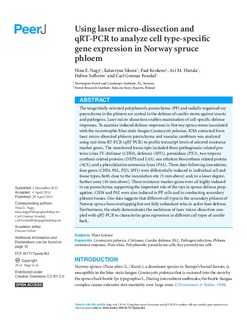| dc.contributor.author | Nagy, Nina Elisabeth | |
| dc.contributor.author | Sikora, Katarzyna | |
| dc.contributor.author | Krokene, Paal | |
| dc.contributor.author | Hietala, Ari | |
| dc.contributor.author | Solheim, Halvor | |
| dc.contributor.author | Fossdal, Carl Gunnar | |
| dc.date.accessioned | 2017-10-12T08:59:05Z | |
| dc.date.available | 2017-10-12T08:59:05Z | |
| dc.date.created | 2014-05-12T13:19:37Z | |
| dc.date.issued | 2014 | |
| dc.identifier.citation | Nagy NE, Sikora K, Krokene P, Hietala AM, Solheim H, Fossdal CG. (2014) Using laser micro-dissection and qRT-PCR to analyze cell type-specific gene expression in Norway spruce phloem. PeerJ 2:e362 | nb_NO |
| dc.identifier.issn | 2167-8359 | |
| dc.identifier.uri | http://hdl.handle.net/11250/2459829 | |
| dc.description.abstract | The tangentially oriented polyphenolic parenchyma (PP) and radially organized ray parenchyma in the phloem are central in the defense of conifer stems against insects and pathogens. Laser micro-dissection enables examination of cell-specific defense responses. To examine induced defense responses in Norway spruce stems inoculated with the necrotrophic blue-stain fungus Ceratocystis polonica, RNA extracted from laser micro-dissected phloem parenchyma and vascular cambium was analyzed using real-time RT-PCR (qRT-PCR) to profile transcript levels of selected resistance marker genes. The monitored transcripts included three pathogenesis-related proteins (class IV chitinase (CHI4), defensin (SPI1), peroxidase (PX3), two terpene synthesis related proteins (DXPS and LAS), one ethylene biosynthesis related protein (ACS), and a phenylalanine ammonia-lyase (PAL). Three days following inoculation, four genes (CHI4, PAL, PX3, SPI1) were differentially induced in individual cell and tissue types, both close to the inoculation site (5 mm above) and, to a lesser degree, further away (10 mm above). These resistance marker genes were all highly induced in ray parenchyma, supporting the important role of the rays in spruce defense propagation. CHI4 and PAL were also induced in PP cells and in conducting secondary phloem tissues. Our data suggests that different cell types in the secondary phloem of Norway spruce have overlapping but not fully redundant roles in active host defense. Furthermore, the study demonstrates the usefulness of laser micro-dissection coupled with qRT-PCR to characterize gene expression in different cell types of conifer bark. | nb_NO |
| dc.language.iso | eng | nb_NO |
| dc.rights | Navngivelse 4.0 Internasjonal | * |
| dc.rights.uri | http://creativecommons.org/licenses/by/4.0/deed.no | * |
| dc.title | Using laser micro-dissection and qRT-PCR to analyze cell type-specific gene expression in Norway spruce phloem | nb_NO |
| dc.type | Journal article | nb_NO |
| dc.type | Peer reviewed | nb_NO |
| dc.description.version | publishedVersion | nb_NO |
| dc.rights.holder | © 2014 Nagy et al. This is an open access article distributed under the terms of the Creative Commons Attribution License, which permits unrestricted use, distribution, and reproduction in any medium, provided the original author and source are credited. | nb_NO |
| dc.source.volume | 2 | nb_NO |
| dc.source.journal | PeerJ | nb_NO |
| dc.identifier.doi | 10.7717/peerj.362 | |
| dc.identifier.cristin | 1132323 | |
| dc.relation.project | Norges forskningsråd: 221479 | nb_NO |
| cristin.ispublished | true | |
| cristin.fulltext | original | |
| cristin.qualitycode | 1 | |

